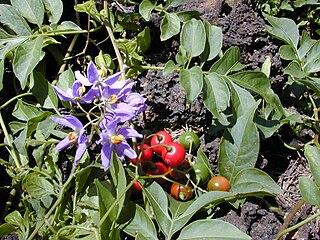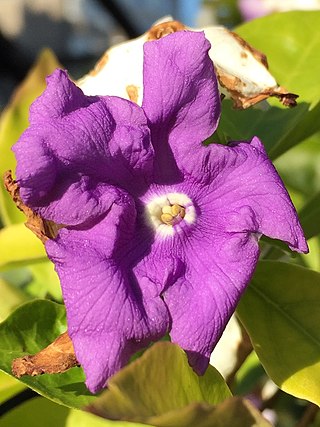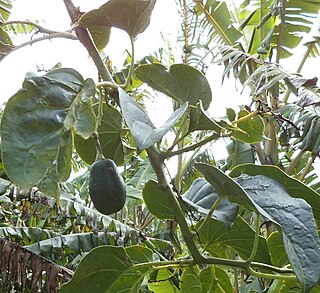
Solanum is a large and diverse genus of flowering plants, which include three food crops of high economic importance: the potato, the tomato and the eggplant. It is the largest genus in the nightshade family Solanaceae, comprising around 1,500 species. It also contains the so-called horse nettles, as well as numerous plants cultivated for their ornamental flowers and fruit.

Buzz pollination or sonication is a technique used by some bees, such as solitary bees, to release pollen which is more or less firmly held by the anthers. The anthers of buzz-pollinated plant species are typically tubular, with an opening at only one end, and the pollen inside is smooth-grained and firmly attached. With self-fertile plants such as tomatoes, wind may be sufficient to shake loose the pollen through pores in the anther and accomplish pollination. Visits by bees may also shake loose some pollen, but more efficient pollination of those plants is accomplished by a few insect species who specialize in sonication or buzz pollination.

Cyphomandra was a formerly accepted genus in the plant family Solanaceae. It used to contain about 35 species native to the Americas from Mexico southwards to Northern Argentina.

Solanum lycocarpum, or wolf apple, is common in the Brazilian savanna, the Cerrado ecoregion. The plant is called lobeira or fruta-do-lobo in Portuguese.

Brunfelsia is a genus of flowering plants belonging to subfamily Petunioideae of the nightshade family Solanaceae. The 50 or so species have been grouped into the three sections: Brunfelsia, Franciscea and Guianenses, which differ significantly in both distribution and characteristics, although molecular data have revealed that only two sections are natural (monophyletic), namely the Caribbean section Brunfelsia and a common section for all South American species. Linnaeus named the genus for the early German herbalist Otto Brunfels (1488–1534).

Butia purpurascens is a smallish, relatively slender, endangered species of Butia palm, up to 3-7m tall. It is locally known as palmeira-jataí, coqueiro-de-vassoura, butiá or coquinho-azedo in Portuguese. The Kalunga people call this palm cabeçudo.
Solanum pseudoquina is a species of plant in the family Solanaceae. It is endemic to Brazil. A rare plant, it is dependent on conservation of its habitat to prevent it from becoming a threatened species.
Solanum ovum-fringillae is a species of plant in the family Solanaceae. It is endemic to Brazil.

Solanum sibundoyense is a species of plant in the family Solanaceae. It is endemic to Colombia, specifically to Sibundoy and surrounding areas, and usually resides in cloud forests, 1400–2300 meters in elevation. It is also known as tomate salvaje or tomate silvestre to natives of Colombia, and also sometimes called Cyphomandra sibundoyensis. It's a small tree 4–8 m tall. Stems glabrous or sparsely puberulent with glandular and eglandular hairs less than 0.5 mm long.

Brunfelsia pauciflora is a species of flowering plant in the family Solanaceae, the nightshades. It is endemic to Brazil, and it is grown in cultivation. A shrubby perennial plant grown in gardens, its common names include today, tomorrow together, yesterday, today and tomorrow, morning-noon-and-night, kiss me quick, and Brazil raintree.

Solanum evolvuloides is a species of Solanum, which was first described in 2011 by Giacomin & Stehmann. Solanum evolvuloides belongs to section Gonatotrichum, a small group assigned to the Brevantherum clade of the genus Solanum. It resembles Solanum turneroides Chodat, sharing with it heterandry, and Solanum parcistrigosum Bitter, with which it shares a similar habit and pubescence. Despite these similarities, the species can be recognized by its ovate-elliptic to cordiform leaf shape and more membranaceous leaf texture than the other species in the section, and stem, inflorescence axes, and calyx vestiture mainly composed of glandular hairs. Solanum evolvuloides is known to occur only in southeastern of Bahia state, Brazil, and in a preliminary assessment of the International Union for Conservation of Nature (IUCN) criteria can be considered a threatened species.

Sirdavidia is a monotypic genus of flowering plants from the family Annonaceae described February 4, 2015, by Thomas L.P. Couvreur of France's Institute of Research for Development, Raoul Niangadouma of the Herbier National du Gabon, Bonaventure Sonké of the University of Yaoundé, and Hervé Sauquet of Université Paris-Sud. The genus was named in honor of Sir David Attenborough. The type species Sirdavidia solannona was discovered and collected in Gabon in Crystal Mountains National Park on November 15, 2013, at elevations of 300–600 meters. The species name refers to the resemblance of the flowers to those of Solanum species.

Mandragora is a plant genus belonging to the nightshade family (Solanaceae). Members of the genus are known as mandrakes. Between three and five species are placed in the genus. The one or two species found around the Mediterranean constitute the mandrake of ancient writers such as Dioscorides. Two or three further species are found eastwards into China. All are perennial herbaceous plants, with large tap roots and leaves in the form of a rosette. Individual flowers are bell-shaped, whitish through to violet, and followed by yellow or orange berries.

The Solanaceae, or the nightshades, are a family of flowering plants that ranges from annual and perennial herbs to vines, lianas, epiphytes, shrubs, and trees, and includes a number of agricultural crops, medicinal plants, spices, weeds, and ornamentals. Many members of the family contain potent alkaloids, and some are highly toxic, but many—including tomatoes, potatoes, eggplant, bell and chili peppers—are used as food. The family belongs to the order Solanales, in the asterid group and class Magnoliopsida (dicotyledons). The Solanaceae consists of about 98 genera and some 2,700 species, with a great diversity of habitats, morphology and ecology.

Solanum conocarpum, commonly known as marron bacoba, is a vascular plant species in the family Solanaceae found in the US Virgin Islands and British Virgin Islands.

Hypericum punctatum, the spotted St. John's wort, is a perennial herb native to North America. The yellow-flowered herb occurs throughout eastern North America into southern Canada. The process of microsporogenesis carried out by this plant is prone to errors in chromosomal segregation. It has a diploid number of 14 or 16. Insects are attracted to the plant's pollen and the hypericin in the plant's leaves is toxic to mammals.

Solanum pachyandrum, known as bombona, is a spine-forming vine of the Solanum genus. It is native to southwestern Ecuador and northwestern Peru where the large juicy fruit is commonly eaten and considered a treat by children. Although the plant has been known and consumed by the indigenous people of that land, it was only published scientifically in 1914 by German botanist Friedrich August Georg Bitter.
Solanum cerasiferum is a species of plant in the nightshade family. It is native to tropical Africa.
Poortmannia is a genus of flowering plants belonging to the family Solanaceae. It is also in Solanoideae subfamily, tribe Solandreae Miers and also subtribe Juanulloinae. The genus has only one known species, Poortmannia speciosaDrake.
















